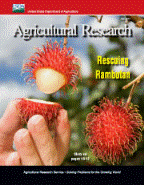United States Department of Agriculture: Agricultural Research Service, Lincoln, Nebraska

Agricultural Research Magazine
Date of this Version
4-2013
Document Type
Article
Citation
Agricultural Research April 2013.
Abstract
Agricultural Research Service researchers in Bushland, Texas, are helping farmers make the most of their water supplies in a region where they depend on the Ogallala Aquifer, a massive underground reservoir under constant threat of overuse.
Steve Evett, Susan O’Shaughnessy, and their colleagues at the Conservation and Production Research Laboratory are developing and testing soil-water and plant-stress sensors and automated irrigation systems that will irrigate fields only as necessary. Automated systems are considered key to sustainable use of the aquifer and to helping growers reduce water and labor costs.
“As water becomes more precious and the costs to pump it continue to rise, we need to tap the potential of every drop used in agriculture. To do that, we need to develop the best systems possible for accurately scheduling and controlling irrigation,” Evett says. The researchers are developing automated irrigation and sensor systems based on two approaches that complement each other, O’Shaughnessy says. One system applies water based on levels of crop water stress detected by wireless sensors mounted on aboveground moving pipelines of commercial irrigation systems.
In the other system, the researchers are adapting sensor technology designed for urban sites so that it will work in agriculture. It triggers irrigation based on soil water content detected by sensors in fixed locations in the soil.
Included in
Agriculture Commons, Animal Sciences Commons, Food Science Commons, Plant Sciences Commons

